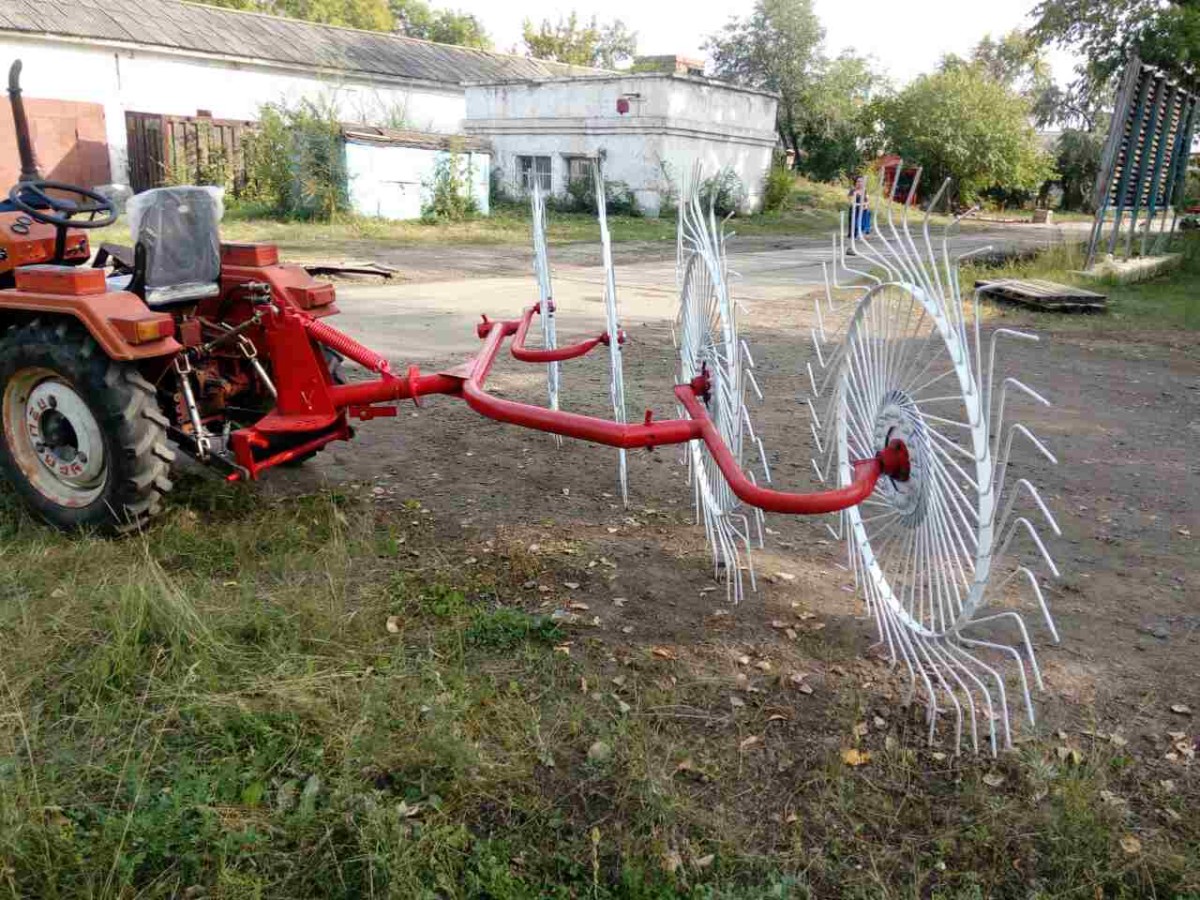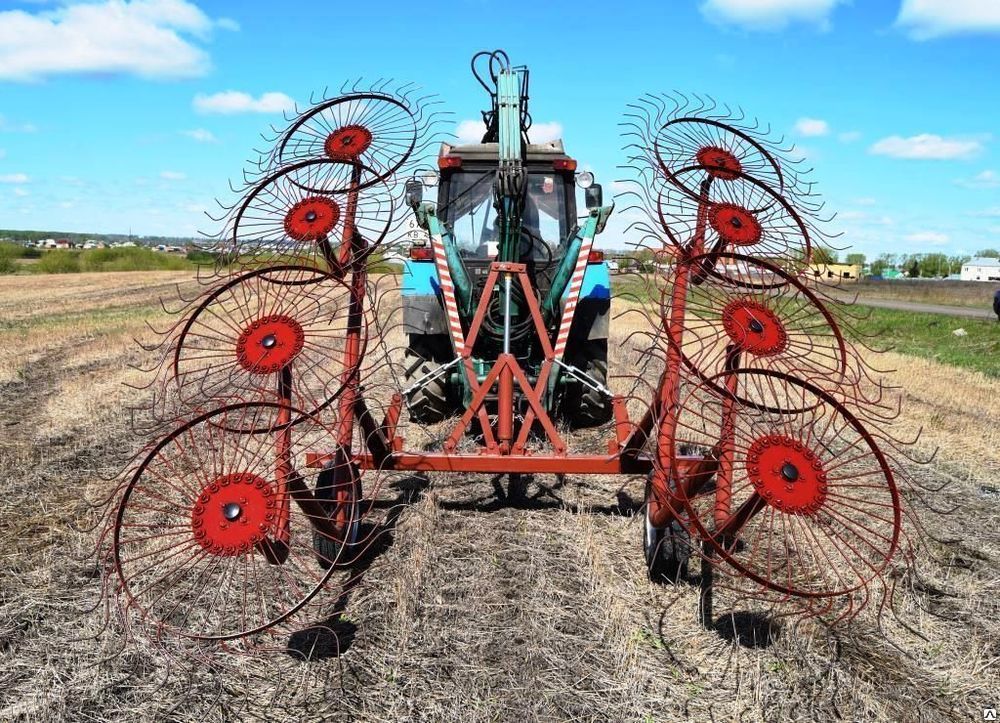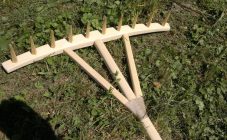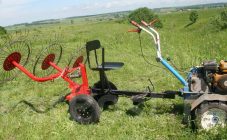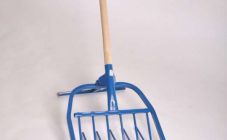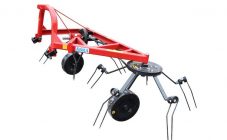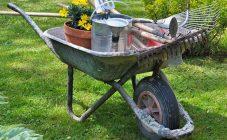Content:
When there is a mini tractor, it becomes possible to use various types of attachments on the farm. One of these options is a tedder rake. The article will describe in detail what they are, what types of rake tedders trailed to a tractor exist, and instructions on how to make them independently are given.
Description
This tedder attachment is designed for two purposes:
- tedding hay;
- shoveling it to one side.
The working part of this type of mounted tractor equipment (Russian, Finnish, Polish or Turkish) in most cases consists of four or five wheels. All of them rotate in the same direction in a plane that is perpendicular to the direction of movement of the minitractor.
In this case, the extreme wheel is slightly ahead of the others, the second is slightly behind, the third is even further, then the fourth and fifth. They all rotate in the same direction.
In each wheel, there are many metal rods around the perimeter, which are slightly curved at the edge in the form of a hook.
In raking mode, the work is as follows.
The wheels, according to the instructions, rotate in such a way that the very first wheel located on the right (if you face in the direction of travel) picks up hay scattered on the ground with metal rods and throws it aside so that it falls under the second wheel. That in exactly the same way throws it under the third, then under the fourth, then under the fifth. The last wheel throws the hay to the left, where it, being collected from the entire working strip of the rake-tedder, is folded into one row.
There are several options for working:
- You can make one pass, then in the opposite direction, so that all the hay falls into one row, where it will be much easier to collect.
- You can make three passes in the same direction, gradually moving the collected hay in one direction. In this case, you will have to collect three times more hay from one row.
Other work patterns are also possible, which can be followed on a tedder rake in this mode.
In tedding mode, the tractor driver rotates the frame with impellers 180 degrees. In this case, the rightmost wheel will be located at the back. The hay he picks up will not fall on the other wheels. The same can be said for each of the wheels.
Benefits
It is possible to use this technique (for example, a GVK rake or a Harvest rake) to achieve the following goals:
- After mowing, dry grass is randomly located on the field. In order to collect hay, you need it to dry well. Here tedding can be applied using such a hitch.
- If the hay has already been collected in rows, sometimes you need to give it the opportunity to dry out additionally. To do this, you can use a trailed rake to turn the rows or just scatter them.
- The cut grass can be raked in neat rows so that later it is convenient to collect hay after it dries well.
- When the hay is already collected in windrows, sometimes it makes sense to combine two or more rows into one. This can also be done with a wheeled rake.
Classification
According to the method of work, the rake-tedders are divided into:
- Wheel and finger devices. The main disadvantage of this type of unit is that it is not designed to work with wet or dry material. The advantages include the practicality and high performance of such devices.
- Drum mounted rake. They have other names: rotary or rotary rakes. Their wheels (using rotors) are located independently of each other. The advantage of this design is its high reliability. This type has the highest cost compared to similar units. Such a rake is capable of forming windrows from hay. In tine tedders, the rings rotate in a horizontal plane. They are actually several metal rods, from each of which several hooks hang down.
- In dental devices in the Russian Federation, the design is in the form of the letter "T". To a short crossbar, located perpendicular to the direction of movement, metal rods are attached, curved in a semicircle, with the convex part up. When the hooks are lowered to the ground, they rake the hay. If they are lifted, a neat swath remains on the ground.
Principle of operation
The hinged device consists of a frame on which several wheels are located. Moreover, each of them is located slightly behind in relation to the previous one. During operation, they are installed so that they touch the ends of the hay rods, and begin to rotate.
The work takes place in raking or tedding mode. In the first case, as a result of rotation, the hay lifted into the air by the front wheel falls under the second. Then it goes to the third, fourth, fifth wheel and turns out to be on the left side of the rake. The hay collected in one row can then be collected with minimal effort.
In tedding mode, the frame with wheels must be turned 180 degrees, after which the rightmost wheel will be behind. When rotating, the hay will not hit the wheel. It will fly into the air and fall to the ground in a new position. Tedding is intended to improve the quality of hay drying.
Manufacturers
The Polish company Bomet produces wheel-finger-type tedders. Here the wheels are located vertically and allow you to adjust the width of the device. They work effectively on various soils.
Wirax, made in Poland, is a tedder that requires a tractor with 25 horsepower. They use 5 wheels. The working width is 330 cm.
Operation and care
This attachment requires very little maintenance. At the same time, at the end of the work, it is necessary to clean the side teeth of the tractor rake from the remains of soil and grass. You need to flush the device regularly. It should be borne in mind that dirt can accumulate not only outside, but also inside the structure.
DIY tedders rake
Such equipment may not be affordable for some farmers. In this case, it makes sense to make your own solar rake. The "Sun" model tedder rake is perfect.
Rake "Sun" refers to wheel-finger devices. For a Russian minitractor, it is recommended to use a five-wheeled model. You can make it yourself.
Before work you need to prepare:
- A frame that can be taken from an old motorcycle.
- The wire from which the hay hooks will be assembled.
- Steel sheets. 4 wheels will be made of them.
- You will need the brackets required to mount the wheels. For each of them, you need to take two bearings.
- Details, with the help of which it will be necessary to assemble the hinge structure for connection to a mini tractor.
For finger wheels, you can use, for example, hubs from Zhiguli.
Rotation is transmitted using a homemade gimbal type construction, for this you can use Italian equipment.
Attaching a tedder rake will help dry and collect the hay. At the same time, the use of such a trailer will provide significant gains in efficiency and productivity.
